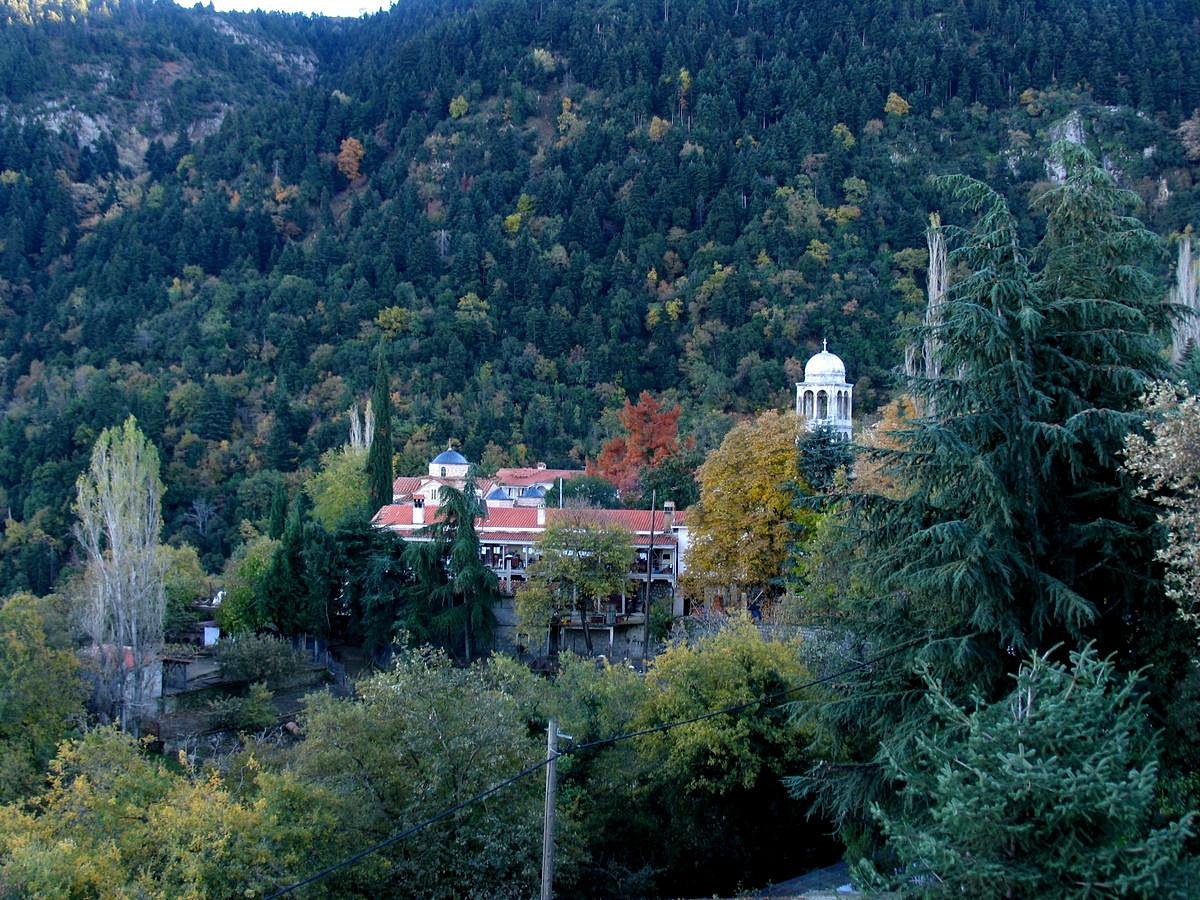
In a magical setting, on the road to Lychno and quite close to Hypati, we find the Holy Monastery of Agathonos, situated at an altitude of 553 meters on the slopes of Mount Oiti. Built in the 14th–15th century, it is a characteristic example of Byzantine architecture.
Oral tradition recounts that the old monastery, where Saint Agathon lived as an ascetic and which was located on the borders of the nearby villages of Lychno and Kastania, suffered a subsidence and the icon of the Virgin Mary disappeared, only to be found in a sunlit cave. There, near its present location, Saint Agathon built the monastery in the 14th–15th century.
Even today, the residents of the surrounding villages, especially those from nearby Lychno, speak of the existence “in the old days” of a monastery in the southwestern part of the village, in a nearby place called “Paliomonastiro” (“Old Monastery”). According to tradition, it was here that the monk Agathon lived, though the exact date is unknown. After the death of Saint Agathon, the monastery was named after him by the monks. Following the destruction caused over time by various raiders in the Hypati area, the Holy Monastery of Agathonos also suffered damage, the most serious being in 1822 by Dramalis, who burned down the katholikon. The first historian to study the Holy Monastery of Agathonos was G. Lambakis, who dated the katholikon to the 15th or 16th century.
Outstanding is the magnificent Athonite-type katholikon (cross-in-square dome, complex tetrastyle with four incorporated chapels), painted in the mid-16th or late 17th century. Today, only a few frescoes survive due to the wear of time and the destructive fury of Dramalis, who set fire to the katholikon in 1822. The revered icon of the Virgin Mary of Agathonos (of the Hodegetria type, covered with an artistic silver revetment) is said to be miraculous.
In the katholikon, the chapels, and other parts of the monastery, there are many inscriptions referring to renovations or rebuilding of structures, such as that of the bell tower:
“This bell tower was built at the expense of Mr. Kon. Koutias and his siblings G., Ana., Ath., Io., Sp., Aik. Koutrei, during the abbacy of Alipios Ch. Georgiou and the councilors Akakios, Philippos, Kon. Ch., on March 3, 1859.”
The monastery preserves many valuable relics and holy remains.
The sacred relics now housed in the monastery’s museum are numerous and of great interest: dozens of crosses, sacred vessels, pyxes, holy relics, icons, vestments, codices, and books were collected from churches and dissolved monasteries in the area by Abbot Germanos Dimakos, thereby saving them from looters.
The oldest book in the library is a treatise by Justin the Philosopher and Martyr, dated 1551, donated by Bishop Philotheos of Zitouni to the monastery. Many liturgical books contain interesting notes by abbots and monks, which hold great historical value for the life of the monastery and the surrounding villages.
The contribution of the monastery during the Greek War of Independence in 1821 was significant. For the success of the struggle, it even sent its own monks to join the fighters under the chieftain Mitsos Kontogiannis from Patradziki. The monastery also hosted regular gatherings of revolutionaries.
For decades, the abbot of the monastery was Archimandrite Germanos Dimakos, the legendary fighter of the National Resistance, known as “Papa-Anypomonos” (“Father Impatient”), a close associate of Aris Velouchiotis. The late Abbot Germanos (born Georgios Dimakos) was born in 1912 in the village of Agridio, Vytina, Gortynia, and was ordained a deacon in 1934.
He served as the military chaplain of the ELAS General Headquarters, offering courage to his comrades and fighting the Germans. Restless in spirit, in those critical times he went to the mountains alongside Aris Velouchiotis. Inside churches, Papa-Anypomonos would swear in the partisans on the Gospel. After the liberation of the country, Germanos Dimakos settled in the Monastery of Agathonos.
His work there was great. Hundreds of faithful from all over Greece came to the monastery to speak with him—some to find comfort in their human weaknesses, others to converse with the “Papa-Anypomonos” of the Resistance. In 2000, the Church of Greece honored him, at the proposal of Archbishop Christodoulos, for his resistance activity. He passed away on Wednesday, June 9, 2004, full of years.
Today, in the monastery grounds and the surrounding area, visitors can enjoy not only the beauty of nature but also experience deep religious sentiment and feel the ongoing effort over time to protect and preserve national consciousness.
Visitors can admire the unique habitat with peacocks, pheasants, partridges, ducks, and various other bird species. They can also see deer, pheasants, mouflons, and partridges in a special enclosure of about 1,200 acres, which is part of the Monastery’s breeding farm. They may also visit the Natural History Museum, whose halls display the main species of fauna and flora of the Oiti National Park.
Over time, the monastery has hosted various schools—clerical, agricultural, and forestry. Today, it operates a game breeding farm and the Oiti Natural History Museum (established in 1953). The monastery celebrates on August 6 and August 15.
Copyright © 2025. REX POLITI RENT ROOMS. All rights reserved.